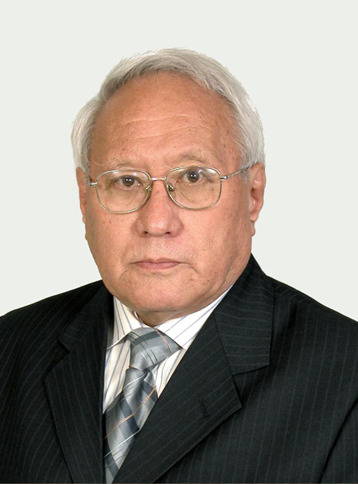
Winner of the State Prize of the Republic of Kazakhstan in the field of science and technology in 2013, leading geomorphologist of Kazakhstan.
Emil Nurmambetov was born in Alma-Ata on November 7, 1934.
In 1958, he graduated from the Geological and Geographical Faculty of S. M. Kirov KazSU with a degree in Prospecting and Exploration of mineral deposits.
At the invitation of one of the founders of Kazakhstan's geology and geomorphology, G. Medoev, he joined the K. I. Satpayev Institute of Geological Sciences the Academy of Sciences of the Kazakh SSR. E. I. Nurmambetov worked here until 1991, having passed all stages of his scientific career: from a laboratory assistant to a scientific secretary and head of the laboratory of exogenous geodynamics.
The first experience of scientific achievements was obtained by him as part of complex geological, geomorphological and hydrogeological studies in the Zhezkazgan-Ulytau region. Independent research on the Inder uplift, on strategically important deposits of boron raw materials, conducted on the initiative of the unforgettable academician K. I. Satpayev, brought impressive results that showed the connection of the daytime relief with the geological structure of the salt dome. The results of research on the Inder salt dome uplift became the subject of a PhD thesis, which E. I. Nurmambetov defended in 1967.
Among his works, a 1:200,000 geomorphological survey of Mangyshlak, Ustyurt, and the Northern Aral Sea region should be noted, which revealed local anticlinal structures that may be promising for oil or gas.
Starting from 1968, carried out systematic work on drawing up a geomorphological map of the entire territory of Kazakhstan, applied to the scale of 1:1,000,000. E. I. Nurmambetov participated in the development of fundamental foundations, approaches and methods, principles of genetic, morphological and age classification of types, forms and elements of relief, in creating a universal legend for this and other areas. other maps. Successful results of the expedition work were obtained. They substantiate the main stages of Saryarka relief formation, indicate the areas of drift and accumulation in the continental conditions of the Kayonozoic, and develop a scheme of paleogeography of the Quaternary period of the region. Analysis of the development history of the northern slope of Saryarka suggests the possibility of detecting a wide range of placers in terrigenous and coastal marine sediments of the Mesozoic and Cenozoic.
In 1991, E. I. Nurmambetov joined the Institute of Geography of the Academy of Sciences of the Kazakh SSR on a competitive basis, where, according to the established new paradigm of geomorphology, he focuses on the dynamics of terrain development, which often leads to undesirable consequences under the conditions of increasing anthropogenic load.
E. I. Nurmambetov continued his research in Western Kazakhstan, where he worked out issues important for areas of intensive development of the oil and gas industry. It is no coincidence that E. I. Nurmambetov is a consultant to companies involved in the exploration and production of hydrocarbons, laying of main pipelines.
The group headed by E. I. Nurmambetov compiled a series of large-scale geomorphological, engineering-geological, hydrogeological and geoecological maps of the Kazakhstan coast of the Caspian Sea. Being a co-author of similar works on the Aral Sea, he sets the task of maximizing the use for scientific purposes of modern transgressions of the Caspian Sea and regressions of the Aral Sea occurring in one natural zone.
A special place in his works is occupied by the geomorphology of the coast and shallow shelf of the Caspian Sea. He clarified the land and underwater boundaries of sea level changes over the past 10 thousand years. The state of the Kazakh coast of the Caspian Sea is determined, the forecast of development at various sea levels is given, and ways of approaching the water area for deploying emergency equipment in case of catastrophic oil spills are recommended.
With the support of international consortia, it was possible to study in detail a significant part of the shallow shelf of the North-Eastern Caspian Sea, to find out the morphometry of the bottom relief, to determine the transport paths of bottom sediments under the influence of wind-wave and seasonal currents, and to determine the effect on the relief of the ice field during hummocks.
The first geomorphological map of the shallow-water shelf of Kazakhstan has been compiled, which identifies various types of underwater plains, large genetically heterogeneous landforms. As the database expanded, the map scale was enlarged to 1: 200,000, and for some sections it was much larger. E. I. Nurmambetov's research laid the foundation for Kazakhstan's marine geomorphology.
E. I. Nurmambetov took part in the development of the concept of scientific atlas mapping of the Republic of Kazakhstan, which was implemented in a multifunctional set of atlases: National (nature, society, ecology of the country), Regional (Mangystau region), Branch (emergency situations). He created dozens of maps with explanatory texts covering the state and forecast of development of the geological and geomorphological environment of Kazakhstan, which is of great scientific and practical value.
For a series of scientific works in the field of atlas mapping, seven scientists of geographers and cartographers of Kazakhstan, including E.I. Nurmambetov, were awarded the State Prize of the Republic of Kazakhstan in the field of science and technology.
Other news


